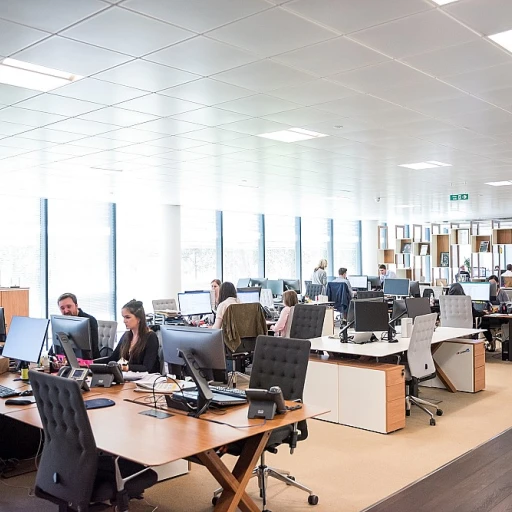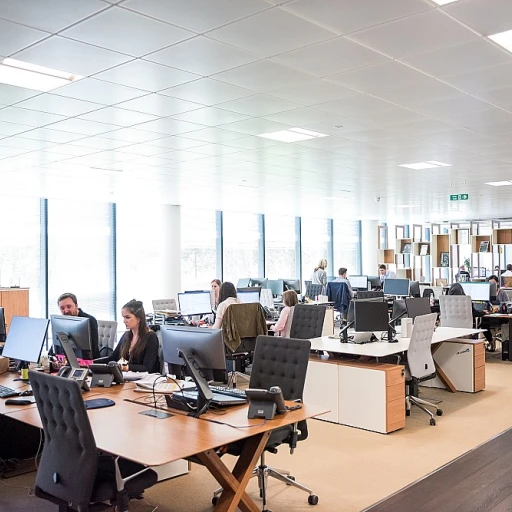Understanding Digital Visitor Manuals
The Shift to Digital Visitor Management in Today's Workplaces
In an era where technology is rapidly transforming business practices, it comes as no surprise that traditional visitor management systems are being re-evaluated. The conventional approach, reliant on paper logs and manual check-ins, is giving way to more efficient, digital visitor solutions. Leveraging technology, these digital visitor manuals offer a streamlined, secure, and compliant alternative for managing guests in the workplace. With visitor management systems evolving, companies are now implementing innovative features that go beyond basic sign-in processes. These digital systems aim to enhance the overall visitor experience while improving access control and ensuring data security. Furthermore, digital visitor manuals enable real-time monitoring and provide detailed insights into visitor data, simplifying the management process significantly. Using a digital guide, UK companies can now automate the entry process, verify visitor credentials, and ensure compliance with industry standards—all while maintaining a robust layer of security and privacy. As highlighted in our blog, this transformation is pivotal for adapting to modern workplace needs and can significantly enhance office management operations. Ultimately, the move towards digitally-based visitor management systems is reshaping how offices function, offering an efficient, secure, and dynamic approach to managing visitor interactions. This shift marks a significant step forward in establishing a more agile and responsive workplace. Detailing the benefits further, our article explores how these digital solutions are revolutionizing visitor management and security within UK companies.Benefits for Office Managers
Elevating the Visitor Experience with Digital Systems
Office managers understand the importance of efficient visitor management in maintaining an organised workplace. Digital visitor manuals introduce a revolution in how visitors are welcomed and managed, streamlining the entire process from check-ins to departure. These digital systems replace outdated paper logs with a sleek, real-time visitor management system that boosts operational efficiency.
One of the main features that stand out is the consolidation of visitor data into a singular, accessible platform. By doing so, office managers can ensure accurate visitor logs are kept, making it easier to track the flow of visitors and ensure compliance with workplace policies. Moreover, the visitor guide offered through the digital platform can be customised to highlight specific information that boosts the visitor experience.
The enhanced security offered by digital systems ensures that access control is tighter, allowing office managers to monitor who enters and exits the premises more effectively. This not only provides real-time updates on visitor movements but also ensures that all interactions are securely logged, fortifying data security.
Another notable aspect is the time saved during the check-in process, which is considerably faster with digital visitor manuals. The reduced check-in time not only benefits guests by minimising wait times but also allows your team to focus on other critical tasks. Furthermore, the implementation of digital visitor management software maintains high levels of compliance with industry regulations, ensuring the security and privacy of staff and guests alike.
For office managers looking to enhance office efficiency with managed services for facilities, digital visitor manuals can be a key component. As these technologies become more prevalent, integrating them into the existing management systems of UK offices will likely result in a smoother, more professional visitor experience.
Implementing Digital Visitor Manuals in UK Offices
Steps to Integrate Digital Manuals into Your Visitor Management System
Implementing digital visitor manuals in UK offices can be a seamless process if approached with a clear strategy. A digital manual can significantly streamline the visitor management process, by enhancing both efficiency and compliance within the workplace.
Here are key steps for integrating a digital visitor manual into your existing management systems:
- Evaluate Current Systems: Begin by reviewing your current visitor management software and procedures. Identify whether your existing management systems support digital integration or if upgrades are necessary.
- Select Compatible Software: Look for digital visitor manual solutions that integrate easily with your current management software. Opt for features that offer real-time data access, seamless visitor check-in processes, and strong data security measures.
- Establish Access Control: Ensure the digital manual aligns with your access control policies, providing clear instructions for visitor sign-in and data compliance. A well-designed digital system can protect both guest and internal data by ensuring secure access only to authorized personnel.
- Train Staff and Visitors: Conduct training sessions for office managers and staff on using the new digital systems. Similarly, create an easy-to-follow visitor guide that aids guests in utilizing the digital manual effectively during their check-ins.
- Monitor and Optimize: Continuously monitor the effectiveness of the digital visitor manual. Regularly check data integrity, system security, and overall visitor experience to optimize the management process. Making necessary adjustments based on feedback and usage data will ensure the system remains efficient and user-friendly.
Successfully implementing digital visitor manuals can transform how a workplace manages visitor data and experiences. For more insights on optimizing systems and processes within your office, you can enhance system efficiency across various office operations.
Addressing Security and Privacy Concerns
Ensuring Robust Security and Privacy
Incorporating digital visitor manuals into the workplace is a progressive step towards modernizing visitor management systems. However, with the shift from paper logs to digital systems, addressing security and privacy concerns becomes paramount. Office managers must ensure that visitor data is handled with the utmost care, aligning with compliance standards and data protection regulations.
The digital visitor management process involves collecting sensitive visitor data, such as personal identification and visit details. This data needs to be securely stored and accessed only by authorized personnel. Implementing robust access control measures within the management software is crucial to prevent unauthorized access and potential data breaches.
Moreover, real-time monitoring features in digital systems can enhance security by providing immediate alerts for any unusual activities during the visitor check process. This proactive approach not only safeguards the workplace but also improves the overall visitor experience by ensuring a secure environment.
Office managers should also consider the transparency of the visitor sign-in process. Providing a clear visitor guide on how their data will be used and stored can build trust and ensure compliance with privacy laws. Regular audits of the digital visitor logbook and management systems will further ensure that all security protocols are up-to-date and effective.
By addressing these security and privacy concerns, office managers can confidently implement digital visitor manuals, enhancing both the efficiency and safety of the visitor management process.
Case Studies from UK Companies
Real-World Applications in Prominent Corporations
In recent years, several prominent UK companies have successfully transitioned to digital visitor management systems, illustrating the tangible benefits of these systems. Through these applications, these companies have not only enhanced their visitor sign-in process but have also improved overall workplace efficiency. One of the key improvements noted has been in the area of data management. Moving away from traditional paper logs, these businesses have adopted digital systems, allowing for real time access to visitor data. This shift has made it easier for office managers to track visitor activities, streamline the check process, and maintain accurate records in a visitor logbook. Moreover, companies have reported significant improvements in security and compliance. By implementing a digital visitor guide, not only are guests provided with a seamless visitor experience, but also issues related to data security are better managed. Utilizing features such as access control and efficient check ins, these systems ensure that only authorized individuals gain entry, enhancing the overall security landscape. Interestingly, the incorporation of advanced visitor management software has also been instrumental in refining corporate protocols. Digital visitor manuals facilitate a more structured management process, providing a robust framework that accommodates both security and visitor convenience. Observers have seen these trends mirrored across various management systems, with digital visitor protocols serving as vital tools in optimizing office operations. By adapting these dynamic solutions, UK companies are setting benchmarks in the efficient handling of both data security and visitor engagement. In sum, the successful deployment by these companies serves as a valuable guide for others considering similar initiatives. The tangible outcomes underscore the effectiveness of adopting digital visitor management systems and the potential they hold for enhancing office management processes.Future Trends in Visitor Management
Embracing the Future of Visitor Management
The landscape of visitor management is evolving rapidly, with digital systems taking center stage. As technology continues to advance, UK offices are poised to benefit from more sophisticated and efficient visitor management systems. These systems not only enhance the visitor experience but also streamline the entire management process.
Integration with Smart Technologies
Future trends indicate a shift towards integrating visitor management systems with smart technologies. This includes using IoT devices for real-time visitor tracking and access control. Such integrations allow for seamless check-ins and improve data accuracy, reducing the reliance on outdated paper logs.
Enhanced Data Security Measures
As digital visitor management systems become more prevalent, ensuring data security remains a top priority. Future systems will likely incorporate advanced encryption methods to protect visitor data. This will address security and privacy concerns, offering peace of mind to both office managers and guests.
AI and Automation in Visitor Management
Artificial Intelligence (AI) and automation are set to revolutionize visitor management. AI-driven features can streamline the check-in process, provide personalized visitor guides, and enhance compliance with workplace regulations. Automated systems will also offer real-time insights into visitor patterns, aiding in more efficient resource allocation.
Cloud-Based Solutions
Cloud-based visitor management systems are expected to become the norm, offering scalability and flexibility. These systems provide remote access to visitor logs and data, enabling office managers to monitor and manage visitor activities from anywhere, at any time.
Focus on Visitor Experience
Finally, future trends will continue to prioritize the visitor experience. User-friendly interfaces, quick sign-in processes, and personalized interactions will enhance the overall experience for guests. As a result, UK offices will not only improve their operational efficiency but also build stronger relationships with their visitors.




-large-teaser.webp)








